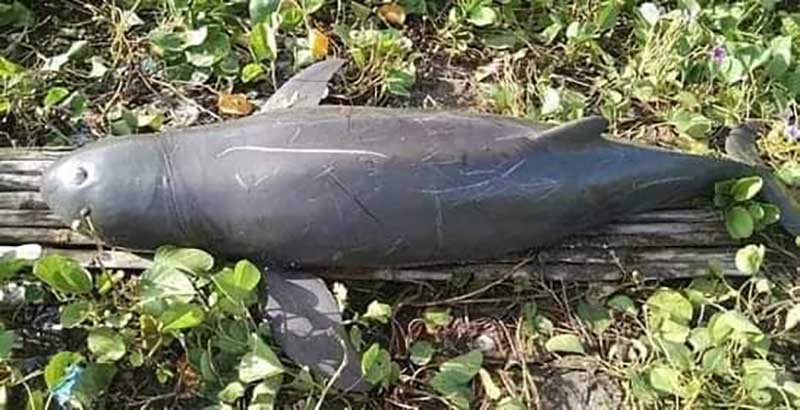The first-ever sighting of an Irrawaddy dolphin off the shore of Calabanga, Camarines Sur, has left scientists of the University of the Philippines excited but concerned over the possibility of as-yet undiscovered marine biodiversity in the region.
Nicknamed “Calab” by the Bureau of Fisheries and Aquatic Resources (BFAR) and the Philippine Marine Mammals Stranding Network (PMMSN), the dolphin was a healthy young female that unfortunately died after it accidentally got entangled in a fisherman’s net in San Miguel Bay off Calabanga, Camarines Sur, last Aug. 16. An autopsy found Caleb’s stomach still full of undigested fish, indicating that she died relatively suddenly and unexpectedly.
“Calab’s death is an unfortunate incident, but it has paved the way to learning more about these rare and beautiful creatures,” said Dr. Lemnuel Aragones, the president of PMMSN and a professor at the Institute of Environmental Science and Meteorology (IESM) at the University of the Philippines Diliman.
Irrawaddy dolphins (Orcaella brevirostris) are characterized by gray or dark-blue backs and pale bellies. O. brevirostris has a high tolerance to various levels of salinity, which enables the species to live in areas where salty seawater and freshwater meet – such as in the mouths of rivers and bays. They are among the world’s most endangered dolphin species, indicated as critically endangered on the Red List of the International Union for Conservation of Nature (IUCN). They are also considered critically endangered by the Philippine Department of Environment and Natural Resources (DENR).
This is the first time that an Irrawaddy dolphin was found on the Pacific or Eastern side of the Philippines. Apart from other Irrawady dolphin populations in South and Southeast Asia, and previous sightings in the Philippines were exclusively in the Western part of the archipelago – in Malampaya Sound, Palawan, and in the Iloilo-Guimaras Strait.
Experts have yet to understand how Irrawaddy dolphins found their way to Palawan, Iloilo, and Bicol. Aragones suggests that they might have been there since prehistoric times, before humans arrived in the archipelago and possibly even before humans existed at all, when environmental conditions were likely optimal for widespread migration.
“Basically, the populations have been there for a very long time, we just didn’t know to look for them,” he explained. Despite needing air to breathe, dolphins generally spend as much as 95% of their lives underwater, enabling them to elude discovery.
Aragones is eager to know more about other possible marine mammal species in San Miguel Bay. Calab is proof, he said, that there is still so much yet to be discovered in the Philippines’ richly biodiverse waters. He and his team of marine mammal scientists and local BFAR personnel are scheduled to visit San Miguel Bay to hopefully find more Irrawaddy dolphins and study them in their natural habitat.
Meanwhile, without a proper survey and understanding of the area’s ecosystems, unregulated human activity could kill off not just Irrawaddy dolphins but other possible as-yet undiscovered species in the area. Unsustainable and illegal fishing practices as well as poorly-planned infrastructure threaten to disrupt local marine environments and biodiversity even before scientists have a chance to study them.
For further information and requests for interviews, please email media@science.upd.edu.ph
A LEARNING OPPORTUNITY. Dr. Lem Aragones (in black mask) and Dr. Mariel Buccat (in gray scrubs) prepare to conduct a detailed study of Calab’s remains. (Photo: Shedy Masayon).





















